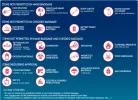PLEASE, can we just STOP with all the dated anecdotal stories about how one or another pilgrim was able to carry their hiking poles onto a commercial aircraft in their rucksack a year or two ago? This back and forth has gone on too long, at least IMHO, and is not helpful.
I believe it is misleading and less than helpful to everyone. Worse, it costs too many pilgrims their hiking poles at the last minute and introduces stress. Starting a Camino off on the wrong foot is never a good way to start any journey...
The aviation security threat changes daily around the world. Security officials and intelligence analysts (I used to be one) in all the western countries constantly evaluate threats, internet chatter, and developing issues or trends. Security is adjusted based on assessments on a regular and ongoing basis.
It is a simple rule of thumb that aviation security only gets tighter and more restrictive as the bad actors around the globe get more clever. We are, none of us, likely to see reduced aviation security during our lifetimes. Please, GET USED TO IT, or do not fly. It is as simple as that.
In the US, for example, I have learned from reliable sources within the government (my pre-retirement employer) that, from November 2017, EVERYTHING in your carry-on larger than a standard paperback book (4" x 6") will have to come out of your carry-on bag for a visual search and x-ray. This is regardless of what the item is made of. You will still need to remove your 3-1-1 pouch of liquids, gels, or pastes.
As the airlines tightened up their checked baggage allowances, charging for everything they possibly can, passengers have been cramming more and varied items into their carry-on bags. This makes it more difficult for aviation screening officials to rapidly assess the threat for all items carried. The increased difficulty slows down processing, and causes longer lines and wait times.
It does not matter how sophisticated the x-ray machine is. Too many items crammed into a bag at all angles can look misleading, deliver incorrect scanning results, or can camouflage restricted items. For example, bars of chocolate you bought as gifts have to the scanner, a density similar to Semtex or Composition 4 (C4) plastic explosives. I am regularly shunted to a secondary swabbing for this issue.
So, as is customary, security officials will reduce the least common denominator to that which they can handle most effectively. I am told this will NOT affect passengers who oped to pay to be pre-vetted in the US TSA-Pre or Global Entry programs.
So, my closing plea to all is this: You planned, saved, and budgeted for your coming Camino. WHY would you jeopardize it over the cost of checking a single bag containing all sharp items, other questionable items, and your hiking poles?
The relative cost of checking a bag works out to about one or two days (at most) expense while on Camino. Personally, I believe the fractional added cost to be insignificant considering the issues involved. Yes, there is always a risk of your checked bag going walkabout on you. Life happens...
But, did you know that international aviation security rules specify that your checked bag MUST travel on the same aircraft as you? Planes are regularly held at departure gates until the passenger list can be reconciled with checked baggage placed on board. The idea is to prevent a bad actor from checking a bag, then not boarding the plane...think about what this means...
In part, it logically means that if your bag does not turn up on the arrival carousel, it went missing on the arrival or connecting flight end, not the departure end. This is why I always attach a "destination" baggage tag, stating where I will be the first night I arrive. The airline can deliver the bag to the hotel I stay in the day or two before I start my Camino. Everything irreplaceable is always with me, in my carry-on.
This is also why I place my rucksack, and hiking poles, inside a brightly colored nylon laundry bag. I want my checked bag to stand out clearly so it attracts baggage handler attention and is not missed (all dark bags look alike). The bright color makes my check bag easier to spot on the baggage carousel, and lessens the likelihood that anyone will inadvertently grab my bag because it looks like theirs.
I sincerely hope this helps resolve this ping-pong issue...





















